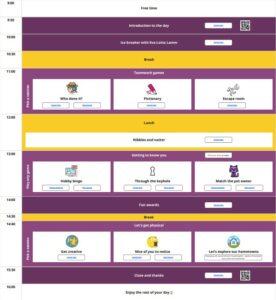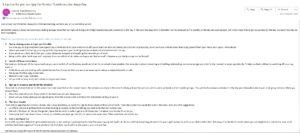As a fairly new formulated team, that was historically two teams, working through the pandemic delivering key services and having a 30% new staff team, we needed a way to connect the team in a virtual world. That’s what we based the theme of the day on, Connectedness.
Overview of how we put together a successful away day:
- Spoke to the team to understand what they needed from an away day.
- Worked together as a multidisciplinary team.
- Got others involved in the day.
- Reflected on what worked, what didn’t and what we might do differently next time.
Doing the rounds
As a team who are focused on the user in our day to day work, we felt it was important that we followed this approach so that the day would reflect the needs of the team.
It was apparent from meeting with the teams and asking what they wanted from a day, that getting to know each other and finding ways to deeper connect from a virtual standpoint was paramount.
This coupled with the need to have time away from the screen became the guiding principles for the day.
How on earth do you do connect people, when the event needs to be hosted online? As a Service Transformation team, we pride ourselves in thinking creatively about problems.
Armed with this information we got our heads together.
Co – Creating
Building a team away day, representative of each of the six disciplines within Service Transformation was part of the success of the day.
Having different representation and ways of thinking was key in building a day that was what people wanted and needed. But this was not without its challenges.
When you put Designers, Communication Personnel, Operational Staff and Improvement Practitioners in the mix you all have different priorities and directions you want to take the day in.
Having a theme and joining team check ins helped us tease out what the team needed from the day meant that we could come back to the reason why we were doing what we were doing.
Collaborating as a multidisciplinary team
To get a day designed and executed within 6 weeks was a scary concept. At times this provoked panic within the team that we would not be able to pull this off.
How wrong we were. Using some basic project management techniques and digital collaboration spaces we set to work formulating ideas for activities.
After several iterations we then tested these ideas out with the team to make sure that we were on the right track. Regular catch ups and having designated tasks supported by a Kanban board held the team accountable and ultimately got us to delivery.
We quickly found out what each of our strengths were and allocated tasks accordingly. Finding out someone has connections to the right people to help, a whizz at creating something amazing on Miro or has a way with words to get people to take notice really helped us move fast.
The day

Getting others involved
We could not have had this day without a team of facilitators who helped us deliver some of the sessions. We also felt it was important for the core team to have fun and be part of the day.
After putting a call out within the various networks within the council we had offers of help, here’s what they had to say about helping us deliver the event.
Simeon Earnshaw, Youth & Community Commissioner - Essex County Council Youth Service.
Through the Keyhole – Into another world for me.
I signed up to facilitate an online activity for the Service Transformation team, which was made up of 6 teams as part of their online Team Building Day. Whilst thinking that it was months away and I wouldn’t have to think or do anything about it for ages, the day came round soon enough.
Then the dreaded lead up to the session. However Bianca made it sound fun and that I was more than capable of delivering the session with this team virtually, including tackling a 'new to me' software package.
Through the Keyhole is based on a TV show where viewers see images of someone’s home and then have to guess who lives there. This was adapted for our session with some of the participants bravely sharing photos of objects and rooms of their homes, with the rest of the group trying to guess whose home it was.
As my age relates to the original Through the Keyhole TV show, I practised and practised my Lloyd Grossman catch phrase “And Who would live in a house like this”? - even though a lot of the participants were from the Keith Lemon generation. One of the comments in chat during the session was that a participant was relieved my session wasn’t based on Keith Lemon.
It was a real honour to work with this group of enthusiastic, inquisitive and generous people. I experienced a team who were supportive, fun and were prepared to fully engage in this game, which made me want to up my game to value their contributions. The group also made me feel very welcome and I really enjoyed both working with a new group and using my skills as a facilitator which have been honed over, many, many years in my professional career as a Youth Worker.
Robert Stannard, Assistant Project Manager - Corporate and Customer
I volunteered because, pre-pandemic, I used to deliver commercial training courses for other councils; it wasn’t a major part of my role, but I’d be facilitating groups of up to fifty a couple of times a month. This stopped in March 2020, so when I saw this come up, it felt like an opportunity to shake off some of the rust and flex a useful skill
I learned that the aspect I always found was key to facilitating a group successfully in the physical realm was the same when facilitating over Teams. As an outsider coming in to work with a group of people who all know each other, you have to break down any social barriers to get people comfortable engaging with you and – maybe more to the point – comfortable engaging with each other whilst you’re present.
Perhaps it’s more natural to do a thorough introduction when you’re physically standing in front of people – I think being able to see people’s body language certainly helps you read the room – but next time I facilitate remotely, I’d make more time to introduce myself at the beginning of the session to break the ice earlier on.
Accessibility
Having a representative from the accessibility team helped us as a group think a bit differently, the takeaway learnt is designing with inclusivity first. By creating a foundation that is accessible to all you can be reasonably sure that the everyone will be able to use it.
So think about what you are trying to do and what is the simplest form it can take. For example we created an accessible programme for the day and shared a visual timetable. Providing two formats allowed users to pick the one they found easiest to use. Top tip is to try different formats and layouts to give your user the options to pick what is right for them.
Communicating with the team
As we all know communication is vital, designing this into the project was necessary to keep everyone informed. Tailoring the communications and using a variety of channels such as in person, via email and on teams to keep everyone informed proved prudent. We thought about the tone of our session, we wanted something relaxed and conveyed that in the way we designed our communications.

Our tone of voice changed, gone was corporate language and formal emails, we wrote top tips to get ready for the day and got users to complete polls so they felt involved in the planning.
When writing content talk to your user as if they were a real person, give them a persona and feelings, write to that person in the way you would advise a friend. Your communication will comes across as not only friendly and approachable but you'll answer most of the questions your users have before they've even thought of it.
Remember people are people with busy lives and you will not always get 100% engagement rates. That’s OK, just making sure you have covered all channels with the right information at the right time is what’s needed.
What went well, what didn't and what we might do better next time
A huge success of the day was the team’s engagement, willingness to take part and willingness to share parts of their world with others. Creating a day that connects people in a virtual world, but away from the screen is challenging, but its possible with a bit of creativity.
- The timetable supported by reminders on teams worked, everyone seemed to find the place they needed to be at the right time.
- We provided a timetable ahead of the day with instructions on what to do and it worked.
- Giving your users time to prepare, gather necessary resources and set a quiet space at home up really helped with the smooth running of the day.
- Having a central place in teams that acted as a 'lobby' to provide links for those who weren't sure where to be or needed a reminder to gather pen and paper for the upcoming session helped too.
- We even saw a bit of banter taking place which was organic conversation amongst people who don't always work together.
There were some definite tech snags that we had to overcome on the day.
- In some games, the collaboration software was playing up.
- We hadn't considered the complexity of tying up multiple things such as different software that needed to run simultaneously.
- There will always be things that don’t work out as planned and that’s ok (our Guess Who game, did not quite work, but was funny).
- Giving yourselves permission to try tools that don’t quite work is ok (Teams breakout rooms, yes the person who created the event has to be on the call who knew?).
- Be honest and up front and usually people will forgive you (forgetting to press record on a session).
- Challenges were inconvenient, but solvable (The share setting on collaborative boards were not quite set right).
All in all, the feedback suggests that the team had a good day, had fun, learnt about each other, laughed and managed to get away from the screen. Bring that back to the theme of the day of connectedness, and yes I think we can call it a success.
The super star core team was made up of:
May Andrews, Chanel Chomse, Bianca Cole, Victoria James, Emma Johnson and Sarah Lieutenant
Leave a comment